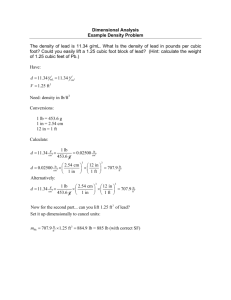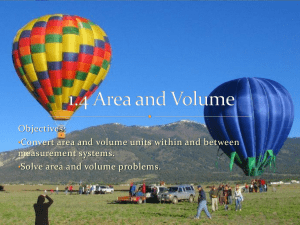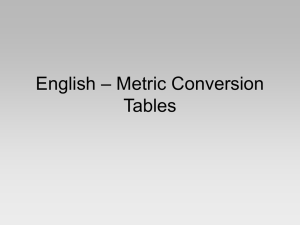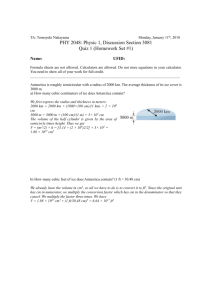GRADE 7 MATH TEACHING GUIDE Lesson 16: Measuring Weight/Mass and Volume
advertisement
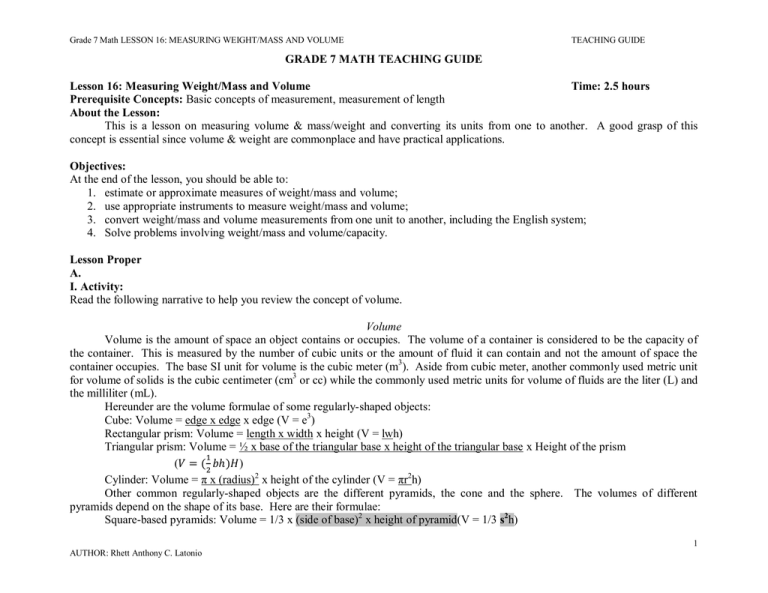
Grade 7 Math LESSON 16: MEASURING WEIGHT/MASS AND VOLUME TEACHING GUIDE GRADE 7 MATH TEACHING GUIDE Lesson 16: Measuring Weight/Mass and Volume Time: 2.5 hours Prerequisite Concepts: Basic concepts of measurement, measurement of length About the Lesson: This is a lesson on measuring volume & mass/weight and converting its units from one to another. A good grasp of this concept is essential since volume & weight are commonplace and have practical applications. Objectives: At the end of the lesson, you should be able to: 1. estimate or approximate measures of weight/mass and volume; 2. use appropriate instruments to measure weight/mass and volume; 3. convert weight/mass and volume measurements from one unit to another, including the English system; 4. Solve problems involving weight/mass and volume/capacity. Lesson Proper A. I. Activity: Read the following narrative to help you review the concept of volume. Volume Volume is the amount of space an object contains or occupies. The volume of a container is considered to be the capacity of the container. This is measured by the number of cubic units or the amount of fluid it can contain and not the amount of space the container occupies. The base SI unit for volume is the cubic meter (m3). Aside from cubic meter, another commonly used metric unit for volume of solids is the cubic centimeter (cm3 or cc) while the commonly used metric units for volume of fluids are the liter (L) and the milliliter (mL). Hereunder are the volume formulae of some regularly-shaped objects: Cube: Volume = edge x edge x edge (V = e3) Rectangular prism: Volume = length x width x height (V = lwh) Triangular prism: Volume = ½ x base of the triangular base x height of the triangular base x Height of the prism ( ) Cylinder: Volume = π x (radius)2 x height of the cylinder (V = πr2h) Other common regularly-shaped objects are the different pyramids, the cone and the sphere. The volumes of different pyramids depend on the shape of its base. Here are their formulae: Square-based pyramids: Volume = 1/3 x (side of base)2 x height of pyramid(V = 1/3 s2h) 1 AUTHOR: Rhett Anthony C. Latonio Grade 7 Math LESSON 16: MEASURING WEIGHT/MASS AND VOLUME TEACHING GUIDE Rectangle-based pyramid: Volume=1/3 x length of the base x width of the base x height of pyramid(V=1/3 lwh) Triangle-based pyramid: Volume = 1/3 x ½ x base of the triangle x height of the triangle x Height of the pyramid ( ) 2 Cone: Volume = 1/3 x π x (radius) x height Sphere: Volume = 4/3 x πx (radius)3 (V = 4/3 πr3) Here are some examples: 1. V = lwh = 3 m x 4 m x 5 m = (3 x 4 x 5) x (m x m x m) = 60 m3 5m 4m 3m 2. V = 1/3 lwh = 1/3 x 3 m x 4 m x 5 m = (1/3 x 3 x 4 x 5) x (m x m x m) = 20 m3 5m 4m 3m Answer the following questions: 1. Cite a practical application of volume. 2. What do you notice about the parts of the formulas that have been underlined? Come up with a general formula for the volume of all the given prisms and for the cylinder. 3. What do you notice about the parts of the formulas that have been shaded? Come up with a general formula for the volume of all the given pyramids and for the cone. II. Questions to Ponder (Post-Activity Discussion) Let us answer the questions in the opening activity: 1. Cite a practical application of volume. Volume is widely used from baking to construction. Baking requires a degree of precision in the measurement of the ingredients to be used thus measuring spoons and cups are used. In construction, volume is used to measure the size of a room, the amount of concrete needed to create a specific column or beam or the amount of water a water tank could hold. 2 AUTHOR: Rhett Anthony C. Latonio Grade 7 Math LESSON 16: MEASURING WEIGHT/MASS AND VOLUME TEACHING GUIDE 2. What do you notice about the parts of the formulas that have been underlined? Come up with a general formula for the volume of all the given prisms and for the cylinder. The formulas that have been underlined are formulas for area. The general formula for the volume of the given prisms and cylinder is just the area of the base of the prisms or cylinder times the height of the prism or cylinder (V = Abaseh). 3. What do you notice about the parts of the formulas that have been shaded? Come up with a general formula for the volume of all the given pyramids and for the cone. The formulas that have been shaded are formulas for the volume of prisms or cylinders. The volume of the given pyramids is just 1/3 of the volume of a prism whose base and height are equal to that of the pyramid while the formula for the cone is just 1/3 of the volume of a cylinder with the same base and height as the cone (V = 1/3 Vprism or cylinder). III. Exercise: Instructions: Answer the following items. Show your solution. 1. How big is a Toblerone box (triangular prism) if its triangular side has a base of 3 cm and a height of 4.5 cm and the box’s height is 25 cm? Volume triangular prism : V=bh/2 H = [(3 cm)(4.5 cm)/2][25 cm] = 168.75 cm3 2. How much water is in a cylindrical tin can with a radius of 7 cm and a height of 20 cm if it is only a quarter full? Step 1: Volumecylinder: V = πr2h Step 2: ¼ V = ¼ (3080 cm3) = (22/7)(7 cm)(7 cm)(20 cm) = 770 cm3 = 3080 cm3 NOTE TO THE TEACHER A common error in this type of problem is not noticing that the problem asks for the volume of water in the tank when it’s only a quarter full. 3. Which of the following occupies more space, a ball with a radius of 4 cm or a cube with an edge of 60 mm? Step 1: Vsphere = 4/3 πr3 Step 2: Vcube = e3 Step 3: Since Vball > Vcube, then = 4/3 (22/7)((4 cm)3) = (6 cm)3 the ball occupies more space = 268.19 cm3 = 216 cm3 than the cube. NOTE TO THE TEACHER One of the most common mistakes involving this kind of problem is the disregard of the units used. In order to accurately compare two values, they must be expressed in the same units. 3 AUTHOR: Rhett Anthony C. Latonio Grade 7 Math LESSON 16: MEASURING WEIGHT/MASS AND VOLUME TEACHING GUIDE B. I. Activity Materials Needed: Ruler / Steel tape measure Different regularly-shaped objects (brick, cylindrical drinking glass, balikbayan box) Instructions: Determine the dimension of the following using the specified metric units only. Record your results in the table below and compute for each object’s volume using the unit used to measure the object’s dimensions. Complete the table by expressing/converting the volume using the specified units. Length BRICK Width Height DRINKING GLASS Radius Height BALIKBAYAN BOX Length Width Height CLASSROOM Length Width Height Unit used* Measurement cm3 Volume m3 in3 ft3 For the unit used, choose ONLY one: centimeter or meter. Answer the following questions: 1. What was your reason for choosing which unit to use? Why? 2. How did you convert the volume from cc to m3 or vice versa? 3. How did you convert the volume from cc to the English units for volume? Volume (continued) The English System of Measurement also has its own units for measuring volume or capacity. The commonly used English units for volume are cubic feet (ft 3) or cubic inches (in3) while the commonly used English units for fluid volume are the pint, quart or gallon. Recall from the lesson on length and area that while the Philippine government has mandated the use of the Metric system, English units are still very much in use in our society so it is an advantage if we know how to convert from the English to the Metric system and vice versa. Recall as well from the previous lesson on measuring length that a unit can be converted into another unit using conversion factors. Hereunder are some of the conversion factors which would help you convert given volume units into the desired volume units: 1 m3 = 1 million cm3 1 gal = 3.79 L 3 3 1 ft = 1,728 in 1 gal = 4 quarts 1 in3 = 16.4 cm3 1 quart = 2 pints 4 AUTHOR: Rhett Anthony C. Latonio Grade 7 Math LESSON 16: MEASURING WEIGHT/MASS AND VOLUME 3 1 m = 35.3 ft TEACHING GUIDE 3 1 pint = 2 cups 1 cup = 16 tablespoons 1 tablespoon = 3 teaspoons Since the formula for volume only requires length measurements, another alternative to converting volume from one unit to another is to convert the object’s dimensions into the desired unit before solving for the volume. For example: 1. How much water, in cubic centimeters, can a cubical water tank hold if it has an edge of 3 meters? Solution 1 (using a conversion factor): i. Volume = e3 = (3 m)3 = 27 m3 ii. 27 m3 x 1 million cm3 /1 m3 = 27 million cm3 Solution 2 (converting dimensions first): i. 3 m x 100 cm / 1 m = 300 cm ii. Volume = e3 = (300 cm)3 = 27 million cm3 II. Questions to Ponder (Post-Activity Discussion) Let us answer the questions in the activity above: 1. What was your reason for choosing which unit to use? Any unit on the measuring instrument may be used but the decision on what unit to use would depend on how big the object is. In measuring the brick, the glass and the balikbayan box, the appropriate unit to use would be centimeter. In measuring the dimensions of the classroom, the appropriate unit to use would be meter. 2. How did you convert the volume from cc to m3 or vice versa? Possible answer would be converting the dimensions to the desired units first before solving for the volume. 3. How did you convert the volume from cc or m3 to the English units for volume? Possible answer would be by converting the dimensions into English units first before solving for the volume. III. Exercises: Answer the following items. Show your solutions. 1. Convert 10 m3 to ft3 10 m3 x 35.94 ft3/1 m3 = 359.4 ft3 NOTE TO THE TEACHER A common error in this type of problem is the use of the conversion factor for meter to feet instead of the conversion factor from m3 to ft3. This conversion factor may be arrived at by computing for the number of cubic feet in 1 cubic meter. 5 AUTHOR: Rhett Anthony C. Latonio Grade 7 Math LESSON 16: MEASURING WEIGHT/MASS AND VOLUME TEACHING GUIDE 2. Convert 12 cups to mL 3. A cylindrical water tank has a diameter of 4 feet and a height of 7 feet while a water tank shaped like a rectangular prism has a length of 1 m, a width of 2 meters and a height of 2 meters. Which of the two tanks can hold more water? By how many cubic meters? Step 1: Vcylinder = πr2h Step 2: Vrectangular prism = lwh = (22/7)(0.61 m)2(2.135 m) = (1 m)(2 m)(2 m) = 2.5 m3 = 4 m3 The rectangular water tank can hold 1.5 m3 more water than the cylindrical water tank. NOTE TO THE TEACHER One of the most common mistakes involving this kind of problem is the disregard of the units used. In order to accurately compare two values, they must be expressed in the same units. C. I. Activity: Problem: The rectangular water tank of a fire truckmeasures 3 m by 4 m by 5 m. How many liters of water can the fire truck hold? Volume (Continued) While capacities of containers are obtained by measuring its dimensions, fluid volume may also be expressed using Metric or English units for fluid volume such as liters or gallons. It is then essential to know how to convert commonly used units for volume into commonly used units for measuring fluid volume. While the cubic meter is the SI unit for volume, the liter is also widely accepted as a SI-derived unit for capacity. In 1964, after several revisions of its definition, the General Conference on Weights and Measures (CGPM) finally defined a liter as equal to one cubic decimeter. Later, the letter L was also accepted as the symbol for liter. This conversion factor may also be interpreted in other ways. Check out the conversion factors below: 1 L = 1 dm3 1 mL = 1 cc 1,000 L = 1 m3 II. Questions to Ponder (Post-Activity Discussion) Let us answer the problem above: Step 1: V = lwh Step 2: 60 m3 x 1,000 L / 1 m3 = 60,000 L = 3m x 4m x 5m = 60 m3 6 AUTHOR: Rhett Anthony C. Latonio Grade 7 Math LESSON 16: MEASURING WEIGHT/MASS AND VOLUME TEACHING GUIDE III. Exercise: Instructions: Answer the following items. Show your solution. 1. A spherical fish bowl has a radius of 21 cm. How many mL of water is needed to fill half the bowl? Vsphere = 4/3 πr3 Since 1 cc = 1 mL, then 38,808 mL of water is needed to fill the tank = (4/3)(22/7)(21 cm)3 = 38,808 cm3 or cc 2. A rectangular container van needs to be filled with identical cubical balikbayan boxes. If the container van’s length, width and height are 16 ft, 4 ft and 6ft, respectively, while each balikbayan box has an edge of 2 ft, what is the maximum number of balikbayan boxes that can be placed inside the van? Step 1: Vvan = lwh Step 2: Vbox = e3 Step 3: Number of boxes = Vvan / Vbox = (16 ft)(4 ft)(6 ft) = (2 ft)3 = 384 ft3 / 8 ft3 = 384 ft3 = 8 ft3 = 48 boxes 3. A drinking glass has a height of 4 in, a length of 2 in and a width of 2 in while a baking pan has a width of 4 in, a length of 8 in and a depth of 2 in. If the baking pan is to be filled with water up to half its depth using the drinking glass, how many glasses full of water would be needed? Step 1: Vdrinking glass = lwh Step 2: Vbaking pan = lwh = (4 in)(2 in)(2 in) = (4 in)(8 in)(2 in) 3 = 16 in = 64 in3 when full -> 32 in3 when half full Step 3: No. of glasses = (1/2)Vpan/Vglass = 32 in3/16 in3 -> 2 glasses of water are needed to fill half the pan D. Activity: Instructions: Fill the table below according to the column headings. Choose which of the available instruments is the most appropriate in measuring the given object’s weight. For the weight, choose only one of the given units. INSTRUMENT* WEIGHT Gram Kilogram Pound ¢25-coin ₱5-coin Small toy marble Piece of brick Yourself *Available instruments: triple-beam balance, nutrition (kitchen) scale, bathroom scale Answer the following questions: 1. What was your reason for choosing which instrument to use? 7 AUTHOR: Rhett Anthony C. Latonio Grade 7 Math LESSON 16: MEASURING WEIGHT/MASS AND VOLUME TEACHING GUIDE 2. What was your reason for choosing which unit to use? 3. What other kinds of instruments for measuring weight do you know? 4. What other units of weight do you know? Mass/ Weight In common language, mass and weight are used interchangeably although weight is the more popular term. Oftentimes in daily life, it is the mass of the given object which is called its weight. However, in the scientific community, mass and weight are two different measurements. Mass refers to the amount of matter an object has while weight is the gravitational force acting on an object. Weight is often used in daily life, from commerce to food production. The base SI unit for weight is the kilogram (kg) which is almost exactly equal to the mass of one liter of water. For the English System of Measurement, the base unit for weight is the pound (lb). Since both these units are used in Philippine society, knowing how to convert from pound to kilogram or vice versa is important. Some of the more common Metric units are the gram (g) and the milligram (mg) while another commonly used English unit for weight is ounces (oz). Here are some of the conversion factors for these units: 1 kg = 2.2 lb 1 g = 1000 mg 1 metric ton = 1000 kg 1 kg = 1000 g 1 lb = 16 oz Use these conversion factors to convert common weight units to the desired unit. For example: Convert 190 lb to kg: II. Questions to Ponder (Post-Activity Discussion) 1. What was your reason for choosing which instrument to use? Possible reasons would include how heavy the object to be weighed to the capacity of the weighing instrument. 2. What was your reason for choosing which unit to use? The decision on which unit to use would depend on the unit used by the weighing instrument. This decision will also be influenced by how heavy the object is. 3. What other kinds of instruments for measuring weight do you know? Other weighing instruments include the two-pan balance, the spring scale, the digital scales. 4. What other common units of weight do you know? Possible answers include ounce, carat and ton. III. Exercise: Answer the following items. Show your solution. 1. Complete the table above by converting the measured weight into the specified units. 2. When Sebastian weighed his balikbayan box, its weight was 34 kg. When he got to the airport, he found out that the airline charged $5 for each lb in excess of the free baggage allowance of 50 lb. How much will Sebastian pay for the excess weight? 8 AUTHOR: Rhett Anthony C. Latonio Grade 7 Math LESSON 16: MEASURING WEIGHT/MASS AND VOLUME Step 1: 34 kg -> lb 34 kg x 2.2 lb / 1 kg = 74.8 lb Step 2: 74.8 lb – 50 = 24.8 lb in excess TEACHING GUIDE Step 3: Payment = (excess lb)($5) = (24.8 lb)($5) = $124.00 3. A forwarding company charges P1,100 for the first 20 kg and P60 for each succeeding 2 kg for freight sent to Europe. How much do you need to pay for a box weighing 88 lb? Step 1: 88 lb -> kg Step 2: (40 – 20)/2 = 10 Step 3: freight charge = ₱1,100 + (10)(₱60) 88 lb x 1 kg / 2.2 lb = 40 kg = ₱1,700.00 Summary In this lesson, you learned: 1) how to determine the volume of selected regularly-shaped solids; 2) that the base SI unit for volume is the cubic meter; 3) how to convert Metric and English units of volume from one to another; 4) how to solve problems involving volume or capacity; 5) that mass and weight are two different measurements and that what is commonly referred to as weight in daily life is actually the mass; 6) how to use weighing intruments to measure the mass/weight of objects and people; 7) how to convert common Metric and English units of weight from one to another; 8) how to solve problems involving mass / weight. 9 AUTHOR: Rhett Anthony C. Latonio
